Detailed Budgeting Report: Restaurant Financial Analysis and Planning
VerifiedAdded on 2020/03/16
|17
|3170
|85
Report
AI Summary
This report analyzes the budgeting practices of two local food businesses, Daniells’ Café and Café Waterside. The report begins with research tasks, including average cheque values and daily sales data, which are then used to create a budgeted monthly income statement for each business. Part B of the report addresses issues related to data sources and the necessary documentation for financial components like rent, wages, and asset purchases. The report includes a balance sheet and definitions of key accounting terminology, such as cash receipts, sales, and journals. Additionally, various financial ratios are calculated and explained, including current ratio, return on assets, and profit margins. The report also provides answers to multiple-choice questions and covers concepts such as trial balance, cash flow equations, and the differences between budgets and variances. Finally, the report examines different types of budgets, including zero-based and rolling budgets.
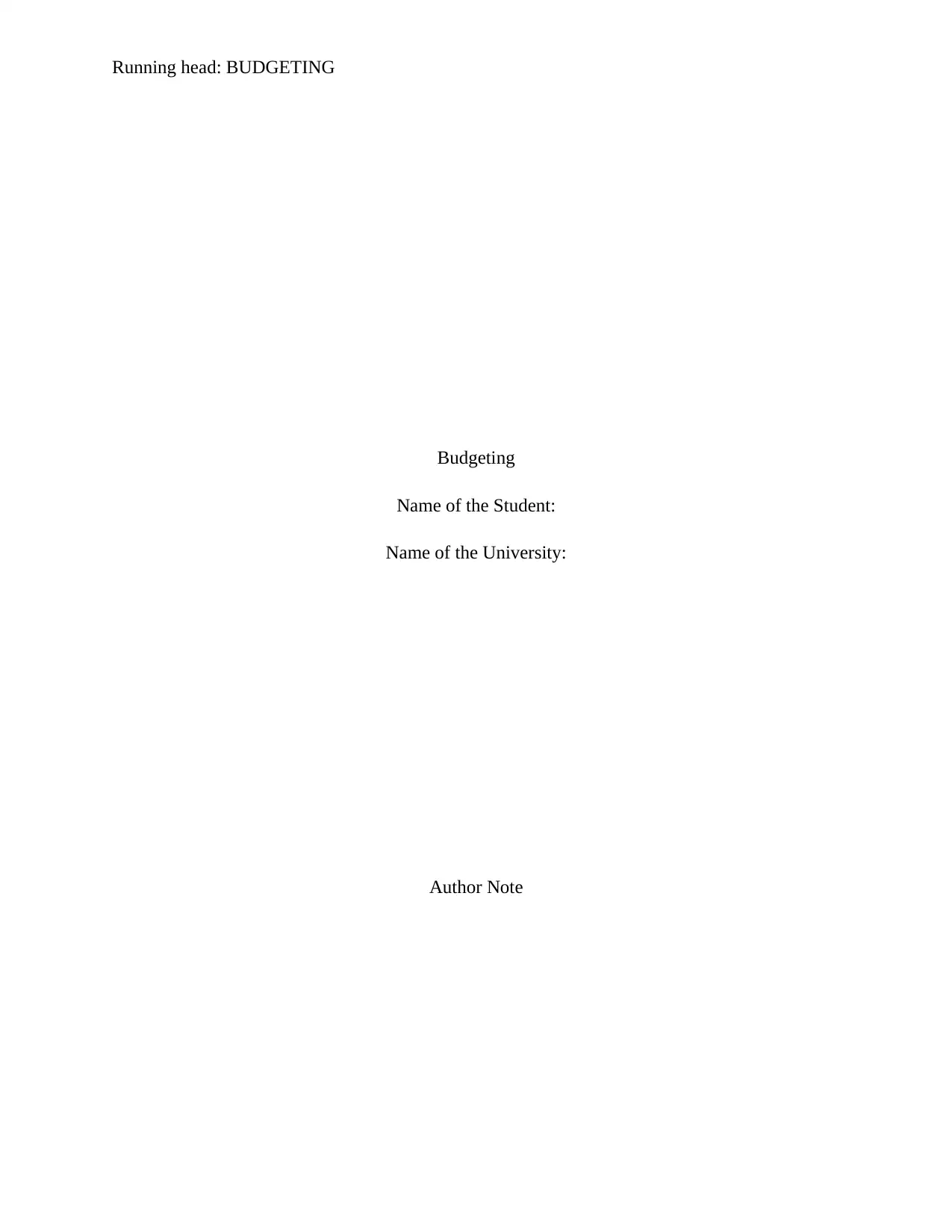
Running head: BUDGETING
Budgeting
Name of the Student:
Name of the University:
Author Note
Budgeting
Name of the Student:
Name of the University:
Author Note
Paraphrase This Document
Need a fresh take? Get an instant paraphrase of this document with our AI Paraphraser
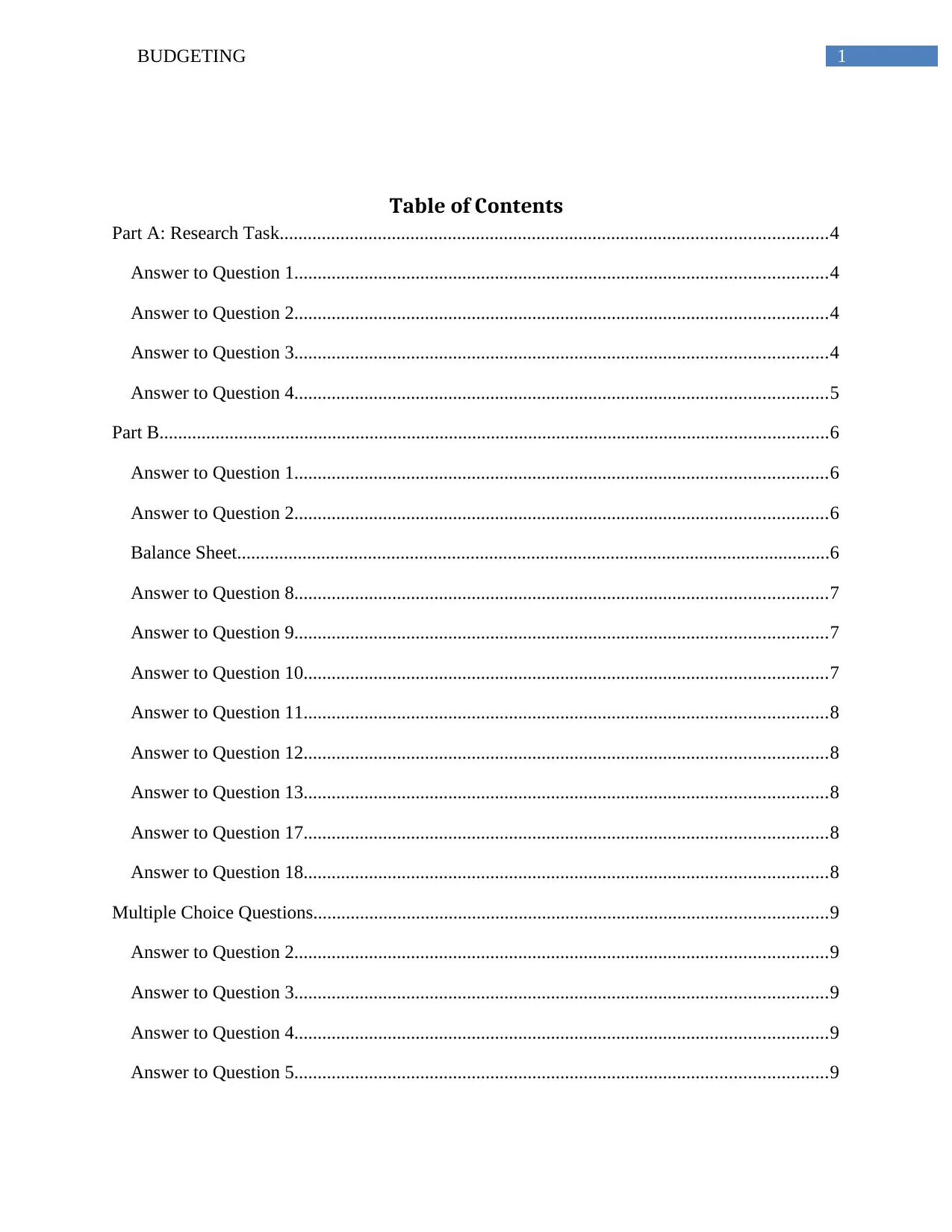
1BUDGETING
Table of Contents
Part A: Research Task.....................................................................................................................4
Answer to Question 1..................................................................................................................4
Answer to Question 2..................................................................................................................4
Answer to Question 3..................................................................................................................4
Answer to Question 4..................................................................................................................5
Part B...............................................................................................................................................6
Answer to Question 1..................................................................................................................6
Answer to Question 2..................................................................................................................6
Balance Sheet...............................................................................................................................6
Answer to Question 8..................................................................................................................7
Answer to Question 9..................................................................................................................7
Answer to Question 10................................................................................................................7
Answer to Question 11................................................................................................................8
Answer to Question 12................................................................................................................8
Answer to Question 13................................................................................................................8
Answer to Question 17................................................................................................................8
Answer to Question 18................................................................................................................8
Multiple Choice Questions..............................................................................................................9
Answer to Question 2..................................................................................................................9
Answer to Question 3..................................................................................................................9
Answer to Question 4..................................................................................................................9
Answer to Question 5..................................................................................................................9
Table of Contents
Part A: Research Task.....................................................................................................................4
Answer to Question 1..................................................................................................................4
Answer to Question 2..................................................................................................................4
Answer to Question 3..................................................................................................................4
Answer to Question 4..................................................................................................................5
Part B...............................................................................................................................................6
Answer to Question 1..................................................................................................................6
Answer to Question 2..................................................................................................................6
Balance Sheet...............................................................................................................................6
Answer to Question 8..................................................................................................................7
Answer to Question 9..................................................................................................................7
Answer to Question 10................................................................................................................7
Answer to Question 11................................................................................................................8
Answer to Question 12................................................................................................................8
Answer to Question 13................................................................................................................8
Answer to Question 17................................................................................................................8
Answer to Question 18................................................................................................................8
Multiple Choice Questions..............................................................................................................9
Answer to Question 2..................................................................................................................9
Answer to Question 3..................................................................................................................9
Answer to Question 4..................................................................................................................9
Answer to Question 5..................................................................................................................9
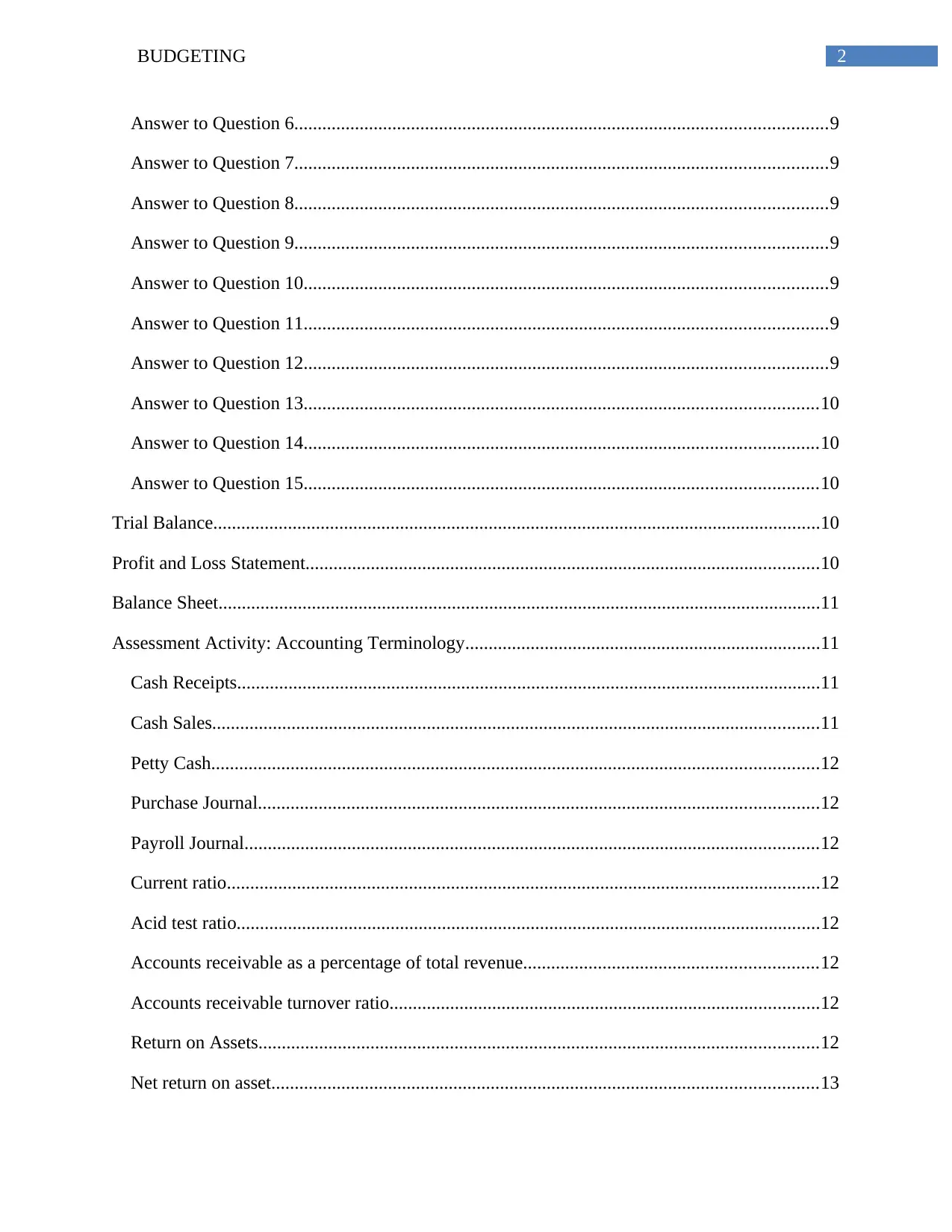
2BUDGETING
Answer to Question 6..................................................................................................................9
Answer to Question 7..................................................................................................................9
Answer to Question 8..................................................................................................................9
Answer to Question 9..................................................................................................................9
Answer to Question 10................................................................................................................9
Answer to Question 11................................................................................................................9
Answer to Question 12................................................................................................................9
Answer to Question 13..............................................................................................................10
Answer to Question 14..............................................................................................................10
Answer to Question 15..............................................................................................................10
Trial Balance..................................................................................................................................10
Profit and Loss Statement..............................................................................................................10
Balance Sheet.................................................................................................................................11
Assessment Activity: Accounting Terminology............................................................................11
Cash Receipts.............................................................................................................................11
Cash Sales..................................................................................................................................11
Petty Cash..................................................................................................................................12
Purchase Journal........................................................................................................................12
Payroll Journal...........................................................................................................................12
Current ratio...............................................................................................................................12
Acid test ratio.............................................................................................................................12
Accounts receivable as a percentage of total revenue...............................................................12
Accounts receivable turnover ratio............................................................................................12
Return on Assets........................................................................................................................12
Net return on asset.....................................................................................................................13
Answer to Question 6..................................................................................................................9
Answer to Question 7..................................................................................................................9
Answer to Question 8..................................................................................................................9
Answer to Question 9..................................................................................................................9
Answer to Question 10................................................................................................................9
Answer to Question 11................................................................................................................9
Answer to Question 12................................................................................................................9
Answer to Question 13..............................................................................................................10
Answer to Question 14..............................................................................................................10
Answer to Question 15..............................................................................................................10
Trial Balance..................................................................................................................................10
Profit and Loss Statement..............................................................................................................10
Balance Sheet.................................................................................................................................11
Assessment Activity: Accounting Terminology............................................................................11
Cash Receipts.............................................................................................................................11
Cash Sales..................................................................................................................................11
Petty Cash..................................................................................................................................12
Purchase Journal........................................................................................................................12
Payroll Journal...........................................................................................................................12
Current ratio...............................................................................................................................12
Acid test ratio.............................................................................................................................12
Accounts receivable as a percentage of total revenue...............................................................12
Accounts receivable turnover ratio............................................................................................12
Return on Assets........................................................................................................................12
Net return on asset.....................................................................................................................13
⊘ This is a preview!⊘
Do you want full access?
Subscribe today to unlock all pages.

Trusted by 1+ million students worldwide
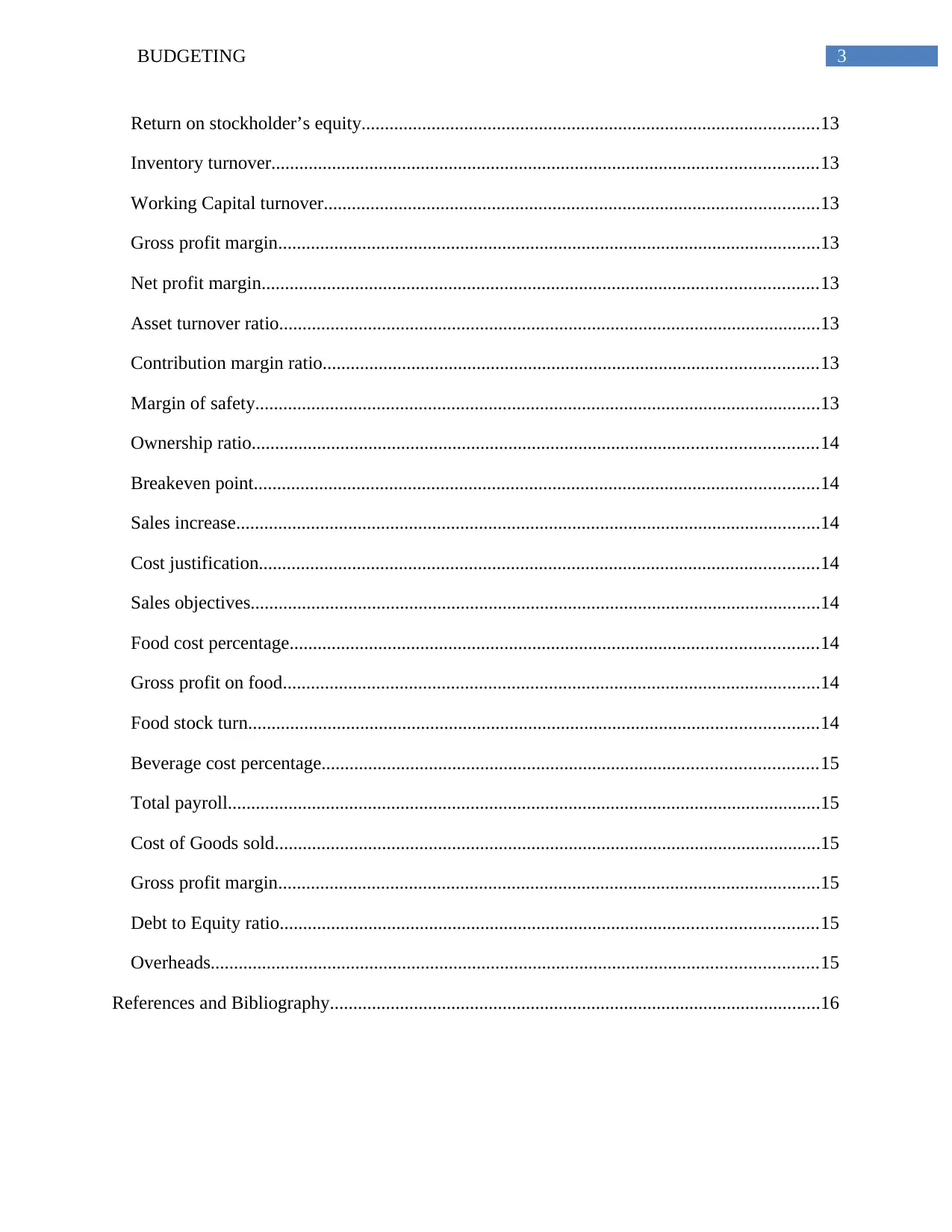
3BUDGETING
Return on stockholder’s equity..................................................................................................13
Inventory turnover.....................................................................................................................13
Working Capital turnover..........................................................................................................13
Gross profit margin....................................................................................................................13
Net profit margin.......................................................................................................................13
Asset turnover ratio....................................................................................................................13
Contribution margin ratio..........................................................................................................13
Margin of safety.........................................................................................................................13
Ownership ratio.........................................................................................................................14
Breakeven point.........................................................................................................................14
Sales increase.............................................................................................................................14
Cost justification........................................................................................................................14
Sales objectives..........................................................................................................................14
Food cost percentage.................................................................................................................14
Gross profit on food...................................................................................................................14
Food stock turn..........................................................................................................................14
Beverage cost percentage..........................................................................................................15
Total payroll...............................................................................................................................15
Cost of Goods sold.....................................................................................................................15
Gross profit margin....................................................................................................................15
Debt to Equity ratio...................................................................................................................15
Overheads..................................................................................................................................15
References and Bibliography.........................................................................................................16
Return on stockholder’s equity..................................................................................................13
Inventory turnover.....................................................................................................................13
Working Capital turnover..........................................................................................................13
Gross profit margin....................................................................................................................13
Net profit margin.......................................................................................................................13
Asset turnover ratio....................................................................................................................13
Contribution margin ratio..........................................................................................................13
Margin of safety.........................................................................................................................13
Ownership ratio.........................................................................................................................14
Breakeven point.........................................................................................................................14
Sales increase.............................................................................................................................14
Cost justification........................................................................................................................14
Sales objectives..........................................................................................................................14
Food cost percentage.................................................................................................................14
Gross profit on food...................................................................................................................14
Food stock turn..........................................................................................................................14
Beverage cost percentage..........................................................................................................15
Total payroll...............................................................................................................................15
Cost of Goods sold.....................................................................................................................15
Gross profit margin....................................................................................................................15
Debt to Equity ratio...................................................................................................................15
Overheads..................................................................................................................................15
References and Bibliography.........................................................................................................16
Paraphrase This Document
Need a fresh take? Get an instant paraphrase of this document with our AI Paraphraser
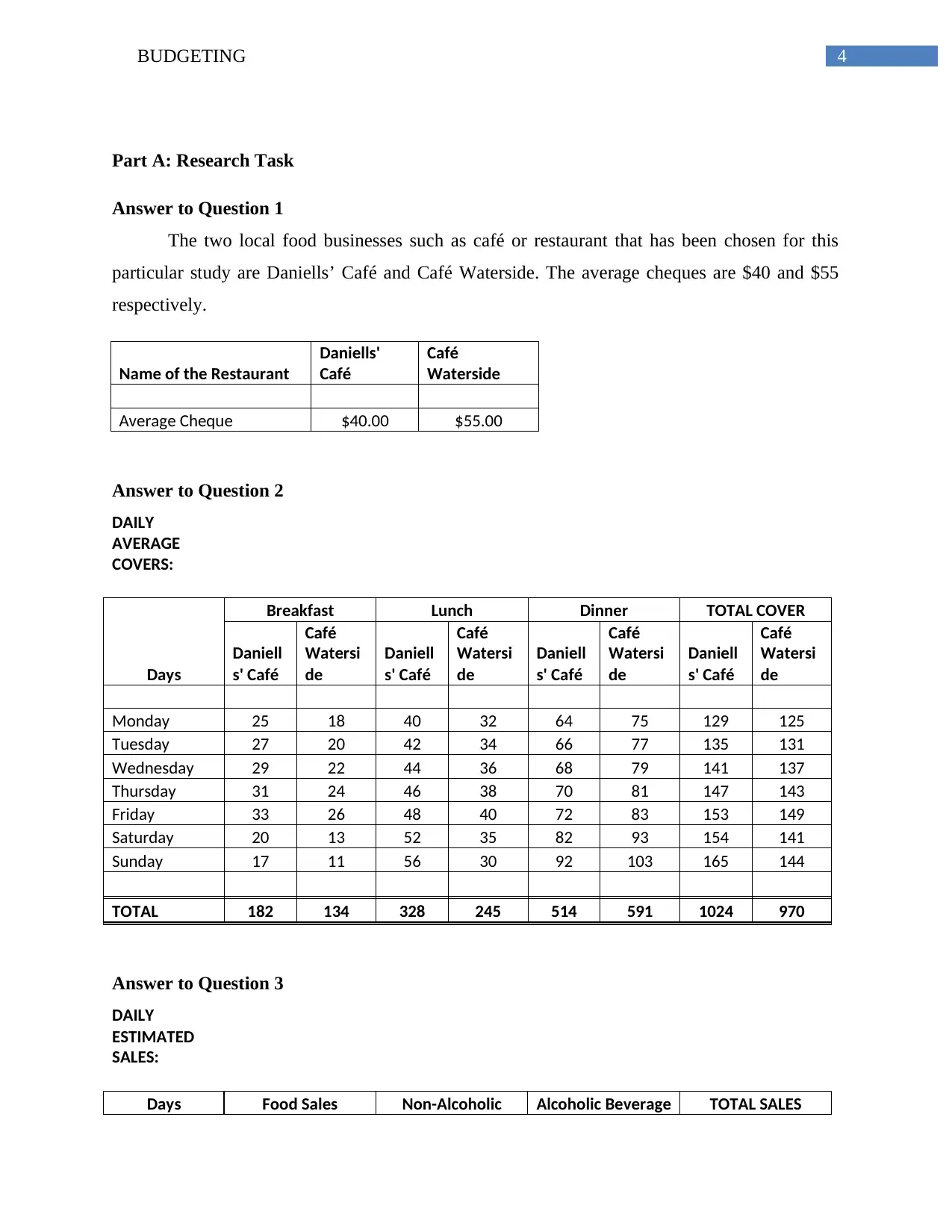
4BUDGETING
Part A: Research Task
Answer to Question 1
The two local food businesses such as café or restaurant that has been chosen for this
particular study are Daniells’ Café and Café Waterside. The average cheques are $40 and $55
respectively.
Name of the Restaurant
Daniells'
Café
Café
Waterside
Average Cheque $40.00 $55.00
Answer to Question 2
DAILY
AVERAGE
COVERS:
Days
Breakfast Lunch Dinner TOTAL COVER
Daniell
s' Café
Café
Watersi
de
Daniell
s' Café
Café
Watersi
de
Daniell
s' Café
Café
Watersi
de
Daniell
s' Café
Café
Watersi
de
Monday 25 18 40 32 64 75 129 125
Tuesday 27 20 42 34 66 77 135 131
Wednesday 29 22 44 36 68 79 141 137
Thursday 31 24 46 38 70 81 147 143
Friday 33 26 48 40 72 83 153 149
Saturday 20 13 52 35 82 93 154 141
Sunday 17 11 56 30 92 103 165 144
TOTAL 182 134 328 245 514 591 1024 970
Answer to Question 3
DAILY
ESTIMATED
SALES:
Days Food Sales Non-Alcoholic Alcoholic Beverage TOTAL SALES
Part A: Research Task
Answer to Question 1
The two local food businesses such as café or restaurant that has been chosen for this
particular study are Daniells’ Café and Café Waterside. The average cheques are $40 and $55
respectively.
Name of the Restaurant
Daniells'
Café
Café
Waterside
Average Cheque $40.00 $55.00
Answer to Question 2
DAILY
AVERAGE
COVERS:
Days
Breakfast Lunch Dinner TOTAL COVER
Daniell
s' Café
Café
Watersi
de
Daniell
s' Café
Café
Watersi
de
Daniell
s' Café
Café
Watersi
de
Daniell
s' Café
Café
Watersi
de
Monday 25 18 40 32 64 75 129 125
Tuesday 27 20 42 34 66 77 135 131
Wednesday 29 22 44 36 68 79 141 137
Thursday 31 24 46 38 70 81 147 143
Friday 33 26 48 40 72 83 153 149
Saturday 20 13 52 35 82 93 154 141
Sunday 17 11 56 30 92 103 165 144
TOTAL 182 134 328 245 514 591 1024 970
Answer to Question 3
DAILY
ESTIMATED
SALES:
Days Food Sales Non-Alcoholic Alcoholic Beverage TOTAL SALES
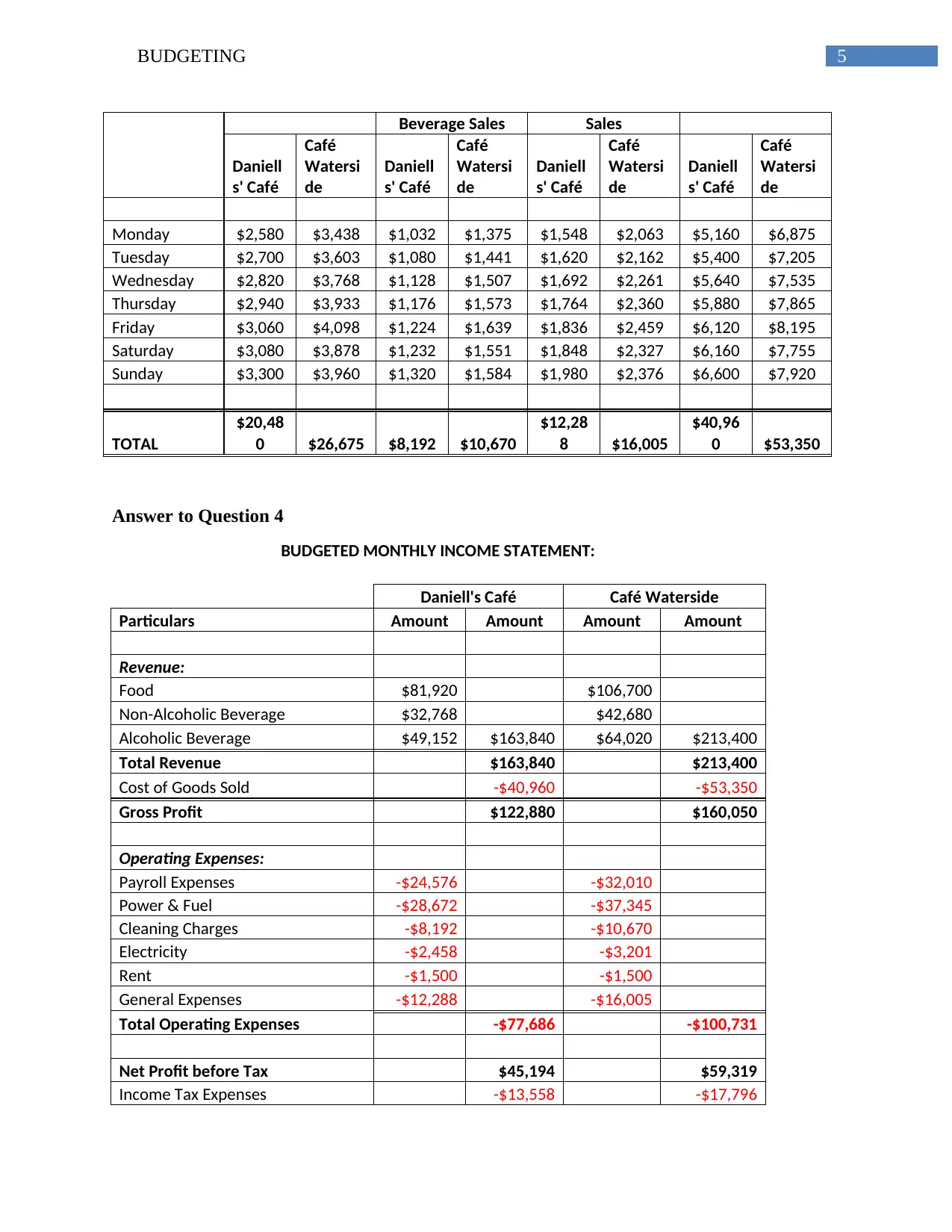
5BUDGETING
Beverage Sales Sales
Daniell
s' Café
Café
Watersi
de
Daniell
s' Café
Café
Watersi
de
Daniell
s' Café
Café
Watersi
de
Daniell
s' Café
Café
Watersi
de
Monday $2,580 $3,438 $1,032 $1,375 $1,548 $2,063 $5,160 $6,875
Tuesday $2,700 $3,603 $1,080 $1,441 $1,620 $2,162 $5,400 $7,205
Wednesday $2,820 $3,768 $1,128 $1,507 $1,692 $2,261 $5,640 $7,535
Thursday $2,940 $3,933 $1,176 $1,573 $1,764 $2,360 $5,880 $7,865
Friday $3,060 $4,098 $1,224 $1,639 $1,836 $2,459 $6,120 $8,195
Saturday $3,080 $3,878 $1,232 $1,551 $1,848 $2,327 $6,160 $7,755
Sunday $3,300 $3,960 $1,320 $1,584 $1,980 $2,376 $6,600 $7,920
TOTAL
$20,48
0 $26,675 $8,192 $10,670
$12,28
8 $16,005
$40,96
0 $53,350
Answer to Question 4
BUDGETED MONTHLY INCOME STATEMENT:
Daniell's Café Café Waterside
Particulars Amount Amount Amount Amount
Revenue:
Food $81,920 $106,700
Non-Alcoholic Beverage $32,768 $42,680
Alcoholic Beverage $49,152 $163,840 $64,020 $213,400
Total Revenue $163,840 $213,400
Cost of Goods Sold -$40,960 -$53,350
Gross Profit $122,880 $160,050
Operating Expenses:
Payroll Expenses -$24,576 -$32,010
Power & Fuel -$28,672 -$37,345
Cleaning Charges -$8,192 -$10,670
Electricity -$2,458 -$3,201
Rent -$1,500 -$1,500
General Expenses -$12,288 -$16,005
Total Operating Expenses -$77,686 -$100,731
Net Profit before Tax $45,194 $59,319
Income Tax Expenses -$13,558 -$17,796
Beverage Sales Sales
Daniell
s' Café
Café
Watersi
de
Daniell
s' Café
Café
Watersi
de
Daniell
s' Café
Café
Watersi
de
Daniell
s' Café
Café
Watersi
de
Monday $2,580 $3,438 $1,032 $1,375 $1,548 $2,063 $5,160 $6,875
Tuesday $2,700 $3,603 $1,080 $1,441 $1,620 $2,162 $5,400 $7,205
Wednesday $2,820 $3,768 $1,128 $1,507 $1,692 $2,261 $5,640 $7,535
Thursday $2,940 $3,933 $1,176 $1,573 $1,764 $2,360 $5,880 $7,865
Friday $3,060 $4,098 $1,224 $1,639 $1,836 $2,459 $6,120 $8,195
Saturday $3,080 $3,878 $1,232 $1,551 $1,848 $2,327 $6,160 $7,755
Sunday $3,300 $3,960 $1,320 $1,584 $1,980 $2,376 $6,600 $7,920
TOTAL
$20,48
0 $26,675 $8,192 $10,670
$12,28
8 $16,005
$40,96
0 $53,350
Answer to Question 4
BUDGETED MONTHLY INCOME STATEMENT:
Daniell's Café Café Waterside
Particulars Amount Amount Amount Amount
Revenue:
Food $81,920 $106,700
Non-Alcoholic Beverage $32,768 $42,680
Alcoholic Beverage $49,152 $163,840 $64,020 $213,400
Total Revenue $163,840 $213,400
Cost of Goods Sold -$40,960 -$53,350
Gross Profit $122,880 $160,050
Operating Expenses:
Payroll Expenses -$24,576 -$32,010
Power & Fuel -$28,672 -$37,345
Cleaning Charges -$8,192 -$10,670
Electricity -$2,458 -$3,201
Rent -$1,500 -$1,500
General Expenses -$12,288 -$16,005
Total Operating Expenses -$77,686 -$100,731
Net Profit before Tax $45,194 $59,319
Income Tax Expenses -$13,558 -$17,796
⊘ This is a preview!⊘
Do you want full access?
Subscribe today to unlock all pages.

Trusted by 1+ million students worldwide
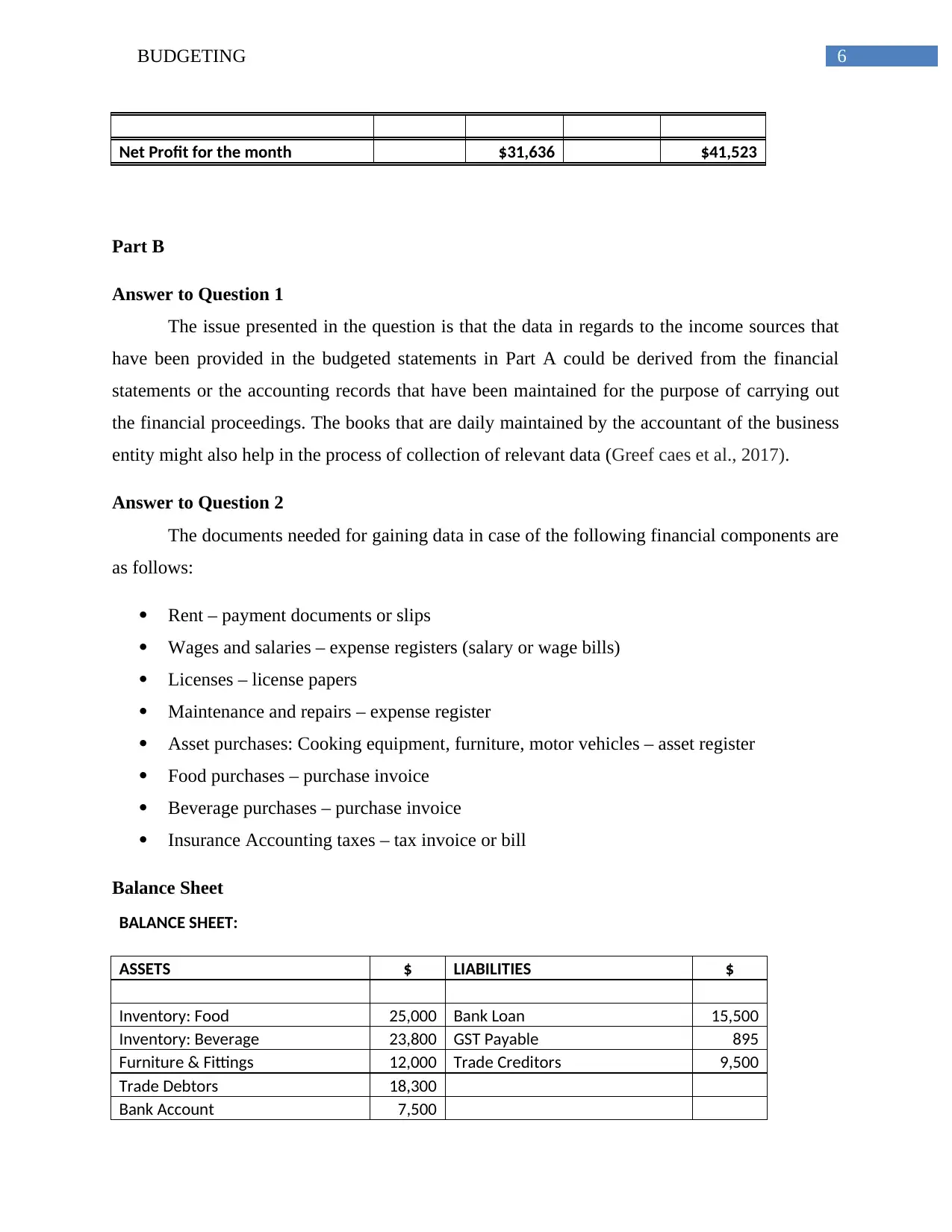
6BUDGETING
Net Profit for the month $31,636 $41,523
Part B
Answer to Question 1
The issue presented in the question is that the data in regards to the income sources that
have been provided in the budgeted statements in Part A could be derived from the financial
statements or the accounting records that have been maintained for the purpose of carrying out
the financial proceedings. The books that are daily maintained by the accountant of the business
entity might also help in the process of collection of relevant data (Greef caes et al., 2017).
Answer to Question 2
The documents needed for gaining data in case of the following financial components are
as follows:
Rent – payment documents or slips
Wages and salaries – expense registers (salary or wage bills)
Licenses – license papers
Maintenance and repairs – expense register
Asset purchases: Cooking equipment, furniture, motor vehicles – asset register
Food purchases – purchase invoice
Beverage purchases – purchase invoice
Insurance Accounting taxes – tax invoice or bill
Balance Sheet
BALANCE SHEET:
ASSETS $ LIABILITIES $
Inventory: Food 25,000 Bank Loan 15,500
Inventory: Beverage 23,800 GST Payable 895
Furniture & Fittings 12,000 Trade Creditors 9,500
Trade Debtors 18,300
Bank Account 7,500
Net Profit for the month $31,636 $41,523
Part B
Answer to Question 1
The issue presented in the question is that the data in regards to the income sources that
have been provided in the budgeted statements in Part A could be derived from the financial
statements or the accounting records that have been maintained for the purpose of carrying out
the financial proceedings. The books that are daily maintained by the accountant of the business
entity might also help in the process of collection of relevant data (Greef caes et al., 2017).
Answer to Question 2
The documents needed for gaining data in case of the following financial components are
as follows:
Rent – payment documents or slips
Wages and salaries – expense registers (salary or wage bills)
Licenses – license papers
Maintenance and repairs – expense register
Asset purchases: Cooking equipment, furniture, motor vehicles – asset register
Food purchases – purchase invoice
Beverage purchases – purchase invoice
Insurance Accounting taxes – tax invoice or bill
Balance Sheet
BALANCE SHEET:
ASSETS $ LIABILITIES $
Inventory: Food 25,000 Bank Loan 15,500
Inventory: Beverage 23,800 GST Payable 895
Furniture & Fittings 12,000 Trade Creditors 9,500
Trade Debtors 18,300
Bank Account 7,500
Paraphrase This Document
Need a fresh take? Get an instant paraphrase of this document with our AI Paraphraser
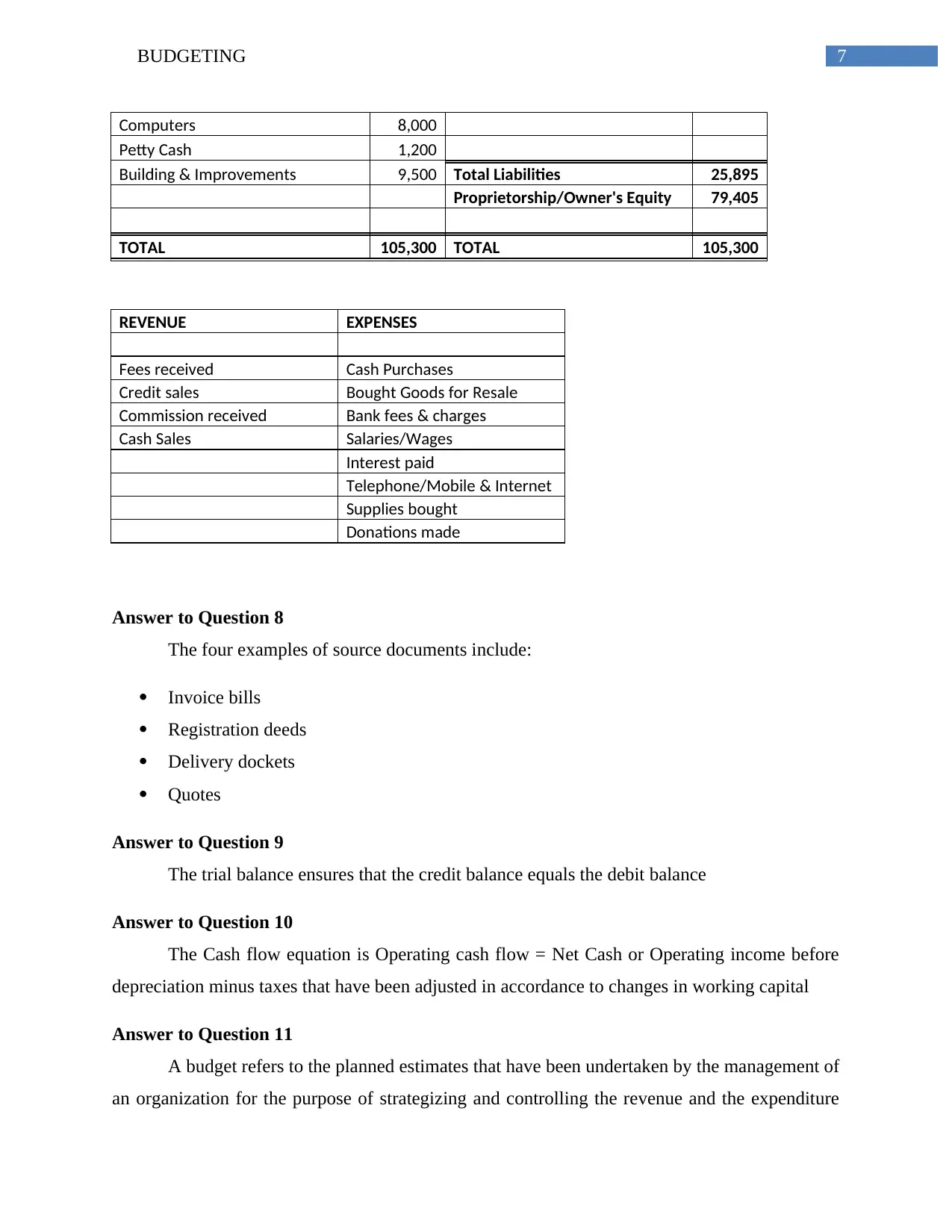
7BUDGETING
Computers 8,000
Petty Cash 1,200
Building & Improvements 9,500 Total Liabilities 25,895
Proprietorship/Owner's Equity 79,405
TOTAL 105,300 TOTAL 105,300
REVENUE EXPENSES
Fees received Cash Purchases
Credit sales Bought Goods for Resale
Commission received Bank fees & charges
Cash Sales Salaries/Wages
Interest paid
Telephone/Mobile & Internet
Supplies bought
Donations made
Answer to Question 8
The four examples of source documents include:
Invoice bills
Registration deeds
Delivery dockets
Quotes
Answer to Question 9
The trial balance ensures that the credit balance equals the debit balance
Answer to Question 10
The Cash flow equation is Operating cash flow = Net Cash or Operating income before
depreciation minus taxes that have been adjusted in accordance to changes in working capital
Answer to Question 11
A budget refers to the planned estimates that have been undertaken by the management of
an organization for the purpose of strategizing and controlling the revenue and the expenditure
Computers 8,000
Petty Cash 1,200
Building & Improvements 9,500 Total Liabilities 25,895
Proprietorship/Owner's Equity 79,405
TOTAL 105,300 TOTAL 105,300
REVENUE EXPENSES
Fees received Cash Purchases
Credit sales Bought Goods for Resale
Commission received Bank fees & charges
Cash Sales Salaries/Wages
Interest paid
Telephone/Mobile & Internet
Supplies bought
Donations made
Answer to Question 8
The four examples of source documents include:
Invoice bills
Registration deeds
Delivery dockets
Quotes
Answer to Question 9
The trial balance ensures that the credit balance equals the debit balance
Answer to Question 10
The Cash flow equation is Operating cash flow = Net Cash or Operating income before
depreciation minus taxes that have been adjusted in accordance to changes in working capital
Answer to Question 11
A budget refers to the planned estimates that have been undertaken by the management of
an organization for the purpose of strategizing and controlling the revenue and the expenditure
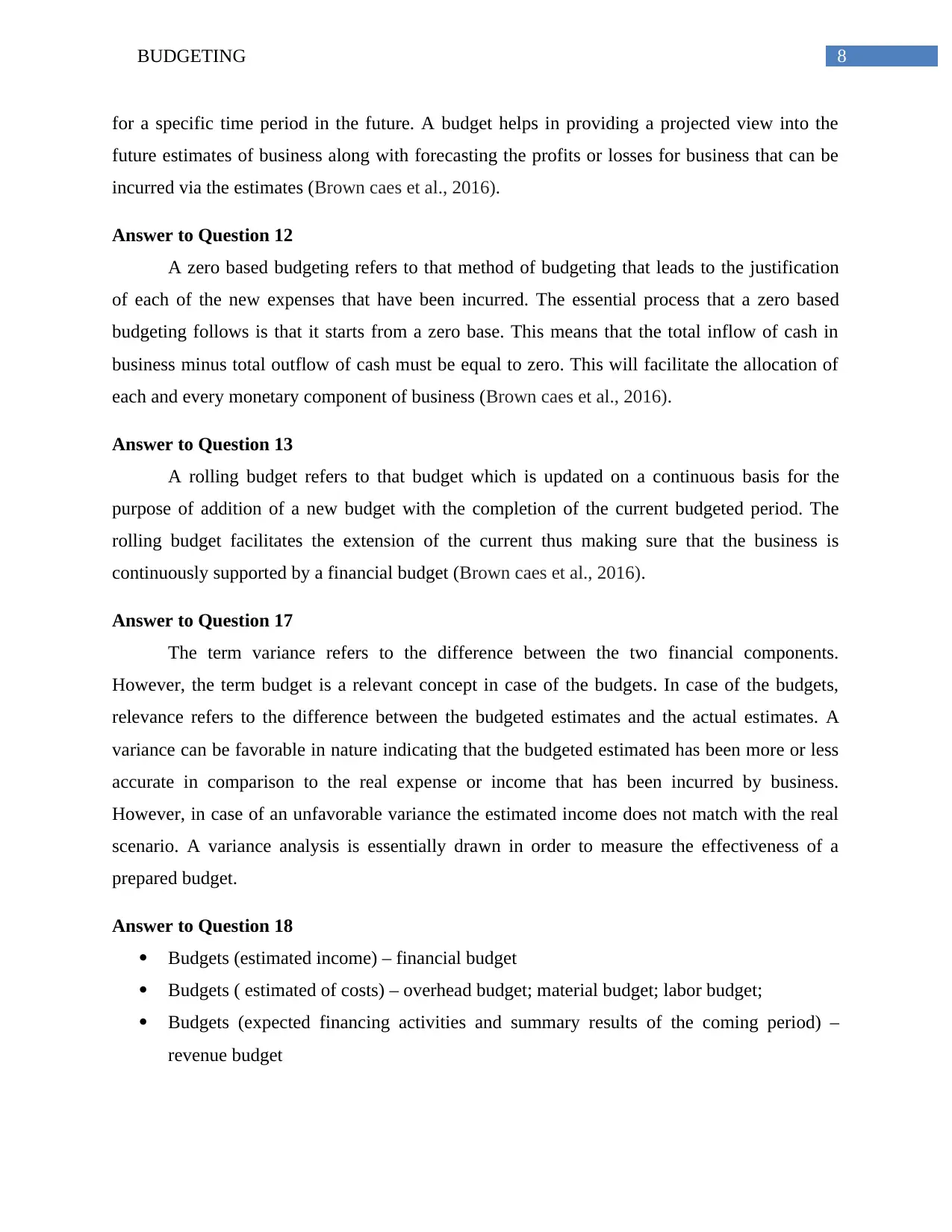
8BUDGETING
for a specific time period in the future. A budget helps in providing a projected view into the
future estimates of business along with forecasting the profits or losses for business that can be
incurred via the estimates (Brown caes et al., 2016).
Answer to Question 12
A zero based budgeting refers to that method of budgeting that leads to the justification
of each of the new expenses that have been incurred. The essential process that a zero based
budgeting follows is that it starts from a zero base. This means that the total inflow of cash in
business minus total outflow of cash must be equal to zero. This will facilitate the allocation of
each and every monetary component of business (Brown caes et al., 2016).
Answer to Question 13
A rolling budget refers to that budget which is updated on a continuous basis for the
purpose of addition of a new budget with the completion of the current budgeted period. The
rolling budget facilitates the extension of the current thus making sure that the business is
continuously supported by a financial budget (Brown caes et al., 2016).
Answer to Question 17
The term variance refers to the difference between the two financial components.
However, the term budget is a relevant concept in case of the budgets. In case of the budgets,
relevance refers to the difference between the budgeted estimates and the actual estimates. A
variance can be favorable in nature indicating that the budgeted estimated has been more or less
accurate in comparison to the real expense or income that has been incurred by business.
However, in case of an unfavorable variance the estimated income does not match with the real
scenario. A variance analysis is essentially drawn in order to measure the effectiveness of a
prepared budget.
Answer to Question 18
Budgets (estimated income) – financial budget
Budgets ( estimated of costs) – overhead budget; material budget; labor budget;
Budgets (expected financing activities and summary results of the coming period) –
revenue budget
for a specific time period in the future. A budget helps in providing a projected view into the
future estimates of business along with forecasting the profits or losses for business that can be
incurred via the estimates (Brown caes et al., 2016).
Answer to Question 12
A zero based budgeting refers to that method of budgeting that leads to the justification
of each of the new expenses that have been incurred. The essential process that a zero based
budgeting follows is that it starts from a zero base. This means that the total inflow of cash in
business minus total outflow of cash must be equal to zero. This will facilitate the allocation of
each and every monetary component of business (Brown caes et al., 2016).
Answer to Question 13
A rolling budget refers to that budget which is updated on a continuous basis for the
purpose of addition of a new budget with the completion of the current budgeted period. The
rolling budget facilitates the extension of the current thus making sure that the business is
continuously supported by a financial budget (Brown caes et al., 2016).
Answer to Question 17
The term variance refers to the difference between the two financial components.
However, the term budget is a relevant concept in case of the budgets. In case of the budgets,
relevance refers to the difference between the budgeted estimates and the actual estimates. A
variance can be favorable in nature indicating that the budgeted estimated has been more or less
accurate in comparison to the real expense or income that has been incurred by business.
However, in case of an unfavorable variance the estimated income does not match with the real
scenario. A variance analysis is essentially drawn in order to measure the effectiveness of a
prepared budget.
Answer to Question 18
Budgets (estimated income) – financial budget
Budgets ( estimated of costs) – overhead budget; material budget; labor budget;
Budgets (expected financing activities and summary results of the coming period) –
revenue budget
⊘ This is a preview!⊘
Do you want full access?
Subscribe today to unlock all pages.

Trusted by 1+ million students worldwide
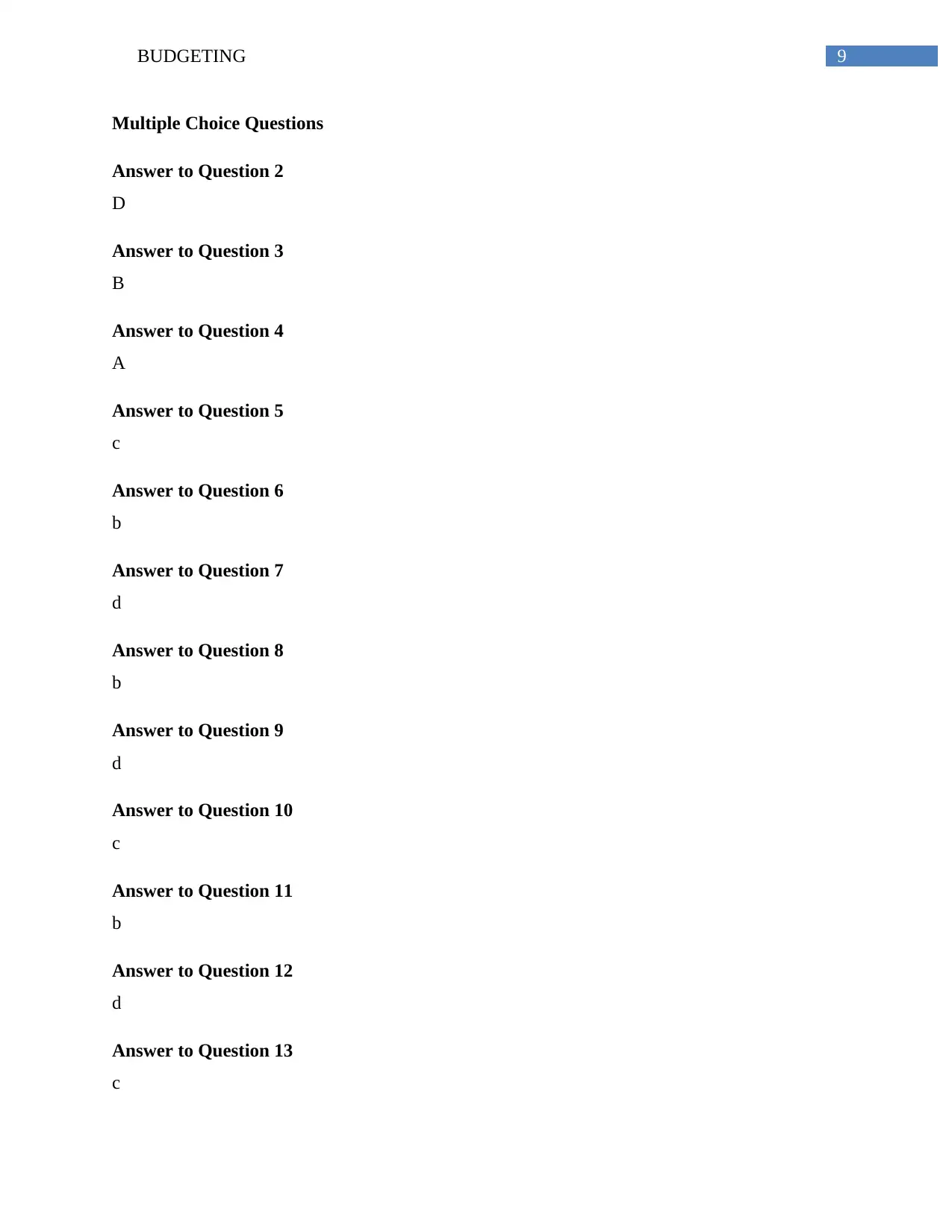
9BUDGETING
Multiple Choice Questions
Answer to Question 2
D
Answer to Question 3
B
Answer to Question 4
A
Answer to Question 5
c
Answer to Question 6
b
Answer to Question 7
d
Answer to Question 8
b
Answer to Question 9
d
Answer to Question 10
c
Answer to Question 11
b
Answer to Question 12
d
Answer to Question 13
c
Multiple Choice Questions
Answer to Question 2
D
Answer to Question 3
B
Answer to Question 4
A
Answer to Question 5
c
Answer to Question 6
b
Answer to Question 7
d
Answer to Question 8
b
Answer to Question 9
d
Answer to Question 10
c
Answer to Question 11
b
Answer to Question 12
d
Answer to Question 13
c
Paraphrase This Document
Need a fresh take? Get an instant paraphrase of this document with our AI Paraphraser
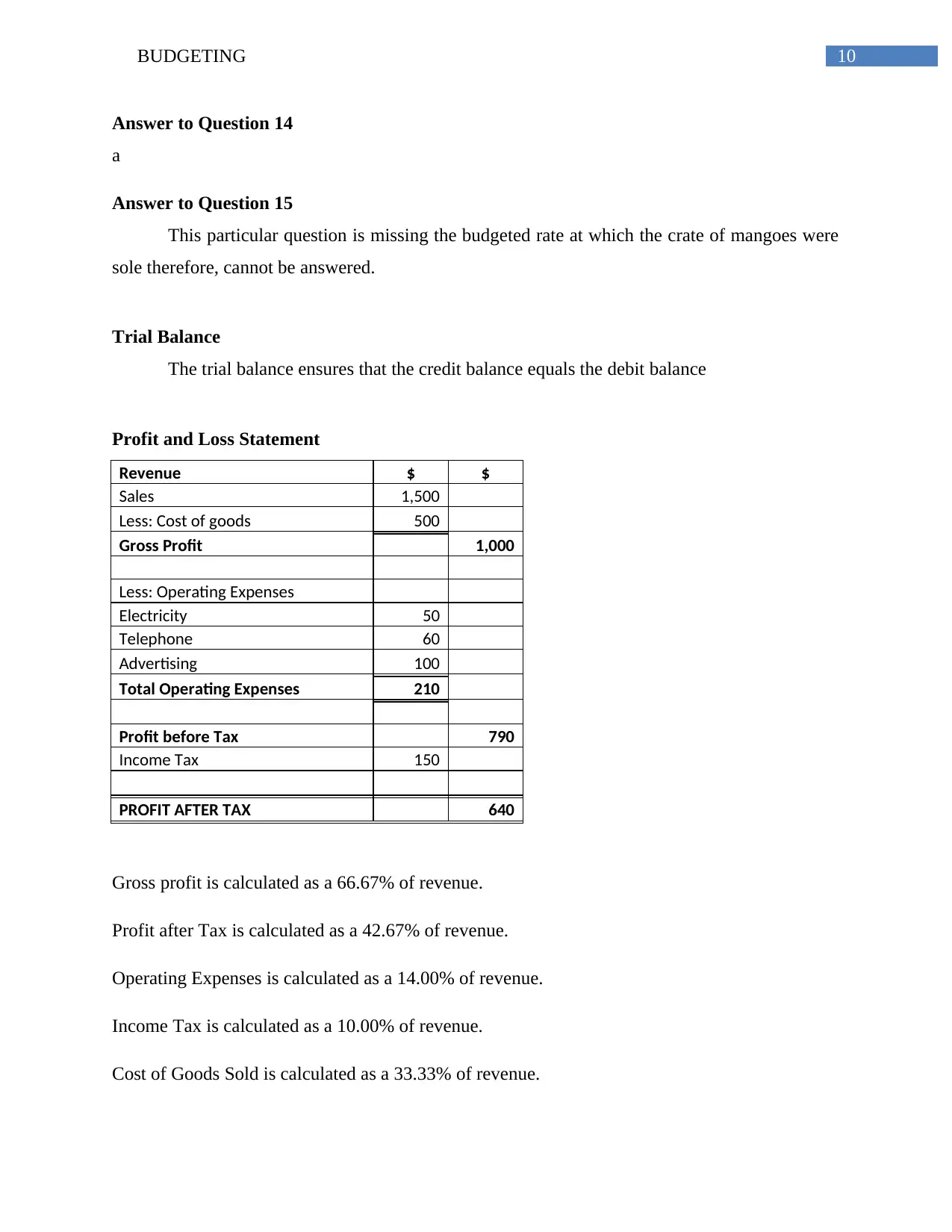
10BUDGETING
Answer to Question 14
a
Answer to Question 15
This particular question is missing the budgeted rate at which the crate of mangoes were
sole therefore, cannot be answered.
Trial Balance
The trial balance ensures that the credit balance equals the debit balance
Profit and Loss Statement
Revenue $ $
Sales 1,500
Less: Cost of goods 500
Gross Profit 1,000
Less: Operating Expenses
Electricity 50
Telephone 60
Advertising 100
Total Operating Expenses 210
Profit before Tax 790
Income Tax 150
PROFIT AFTER TAX 640
Gross profit is calculated as a 66.67% of revenue.
Profit after Tax is calculated as a 42.67% of revenue.
Operating Expenses is calculated as a 14.00% of revenue.
Income Tax is calculated as a 10.00% of revenue.
Cost of Goods Sold is calculated as a 33.33% of revenue.
Answer to Question 14
a
Answer to Question 15
This particular question is missing the budgeted rate at which the crate of mangoes were
sole therefore, cannot be answered.
Trial Balance
The trial balance ensures that the credit balance equals the debit balance
Profit and Loss Statement
Revenue $ $
Sales 1,500
Less: Cost of goods 500
Gross Profit 1,000
Less: Operating Expenses
Electricity 50
Telephone 60
Advertising 100
Total Operating Expenses 210
Profit before Tax 790
Income Tax 150
PROFIT AFTER TAX 640
Gross profit is calculated as a 66.67% of revenue.
Profit after Tax is calculated as a 42.67% of revenue.
Operating Expenses is calculated as a 14.00% of revenue.
Income Tax is calculated as a 10.00% of revenue.
Cost of Goods Sold is calculated as a 33.33% of revenue.
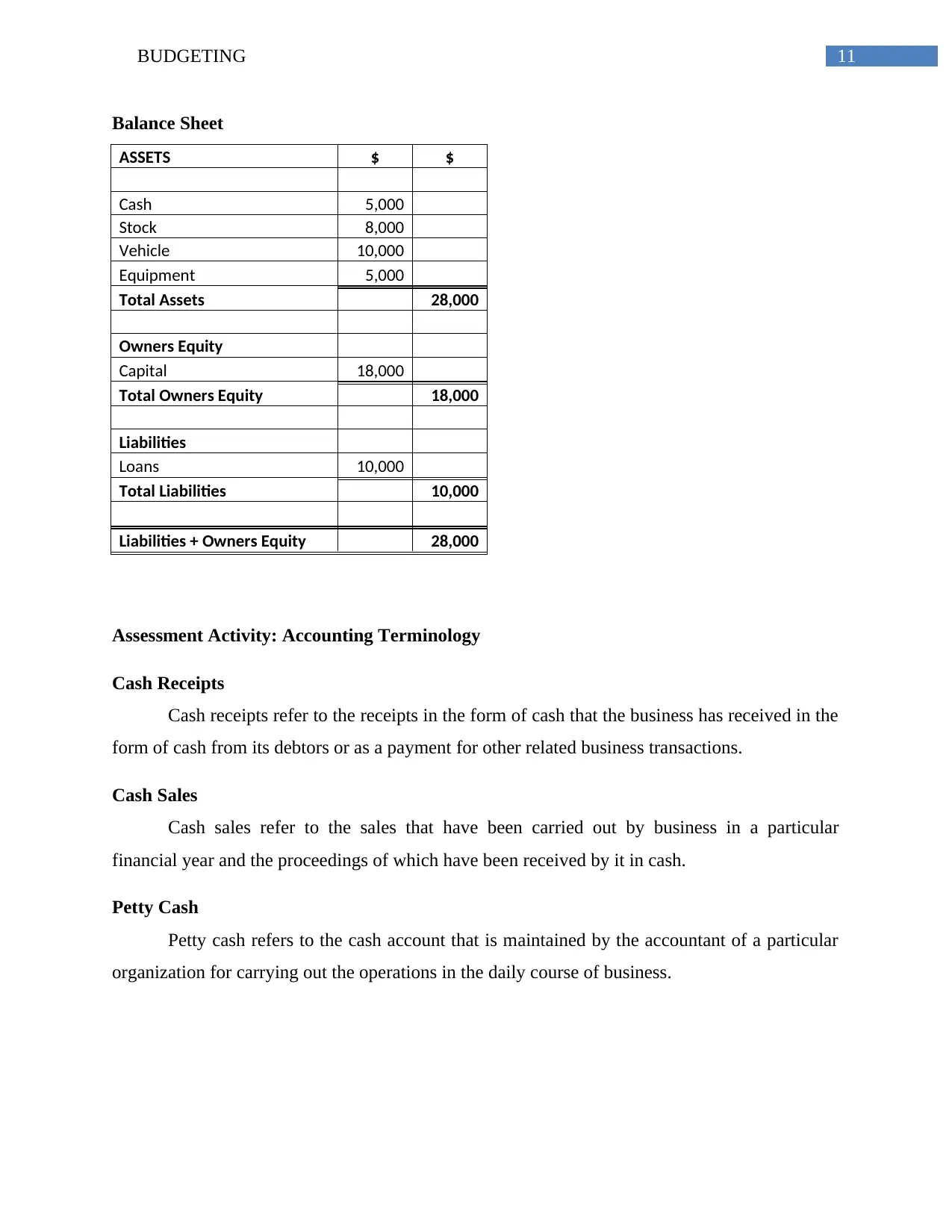
11BUDGETING
Balance Sheet
ASSETS $ $
Cash 5,000
Stock 8,000
Vehicle 10,000
Equipment 5,000
Total Assets 28,000
Owners Equity
Capital 18,000
Total Owners Equity 18,000
Liabilities
Loans 10,000
Total Liabilities 10,000
Liabilities + Owners Equity 28,000
Assessment Activity: Accounting Terminology
Cash Receipts
Cash receipts refer to the receipts in the form of cash that the business has received in the
form of cash from its debtors or as a payment for other related business transactions.
Cash Sales
Cash sales refer to the sales that have been carried out by business in a particular
financial year and the proceedings of which have been received by it in cash.
Petty Cash
Petty cash refers to the cash account that is maintained by the accountant of a particular
organization for carrying out the operations in the daily course of business.
Balance Sheet
ASSETS $ $
Cash 5,000
Stock 8,000
Vehicle 10,000
Equipment 5,000
Total Assets 28,000
Owners Equity
Capital 18,000
Total Owners Equity 18,000
Liabilities
Loans 10,000
Total Liabilities 10,000
Liabilities + Owners Equity 28,000
Assessment Activity: Accounting Terminology
Cash Receipts
Cash receipts refer to the receipts in the form of cash that the business has received in the
form of cash from its debtors or as a payment for other related business transactions.
Cash Sales
Cash sales refer to the sales that have been carried out by business in a particular
financial year and the proceedings of which have been received by it in cash.
Petty Cash
Petty cash refers to the cash account that is maintained by the accountant of a particular
organization for carrying out the operations in the daily course of business.
⊘ This is a preview!⊘
Do you want full access?
Subscribe today to unlock all pages.

Trusted by 1+ million students worldwide
1 out of 17
Related Documents
Your All-in-One AI-Powered Toolkit for Academic Success.
+13062052269
info@desklib.com
Available 24*7 on WhatsApp / Email
![[object Object]](/_next/static/media/star-bottom.7253800d.svg)
Unlock your academic potential
Copyright © 2020–2025 A2Z Services. All Rights Reserved. Developed and managed by ZUCOL.





